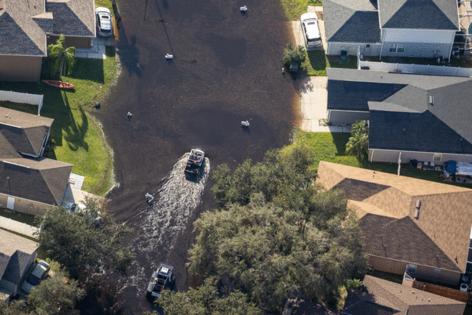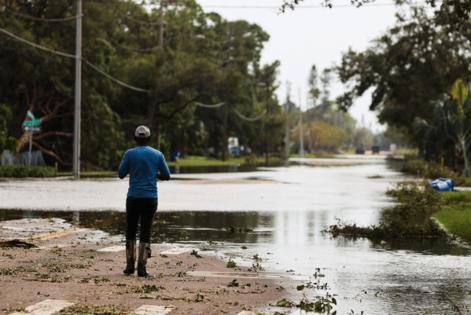Hurricane Milton was yet another pollution nightmare for Tampa Bay
Published in Weather News
TAMPA BAY, Fla. — Florida’s largest open water estuary and the millions of people who have built their lives around it barely had enough time to detox from the last hurricane-fueled wave of pollution before the next one hit.
Just as the Tampa Bay area was cleaning the mess from Hurricane Helene, along came Milton. The hurricane double-header doused piles of debris in floodwaters. Then Milton stirred up the pools of muck that had finally started to dry. The smells of spilled sewage, just beginning to fade, soured the air once more.
Through Friday, local governments and utilities across the region had alerted state environmental regulators to more than 160 spills and pollution events from Milton.
When pumps lost power, when drains backed up and infrastructure failed, dirty water was cut loose into roads, homes and waterways.
According to a Tampa Bay Times review of reports to state regulators, an estimated 68 million gallons of spilled pollution has been reported so far across seven counties, a number that is likely a vast undercount and sure to rise as wastewater managers learn more about how facilities fared.
Reports show more than 30 of the region’s waterways, from Tampa Bay to Lake Seminole, were polluted from Milton.
Tropical Storm Debby in August, then Hurricane Helene in September, had tested the region’s sewer systems like never before. These latest pollution reports from Milton, once again, paint an increasingly common picture of what happens when a growing metro area has stormwater infrastructure that can’t keep up with blistering growth.
Take just a few examples of some of the largest spills:
As Milton barreled toward land on Oct. 9 with relentless rain, the city of Bradenton began dumping what would become an estimated 20 million gallons of partially treated wastewater into the Manatee River.
Four days later, the city’s treatment facility ran out of a chemical needed to clean wastewater. Back-to-back storms had delayed the shipment. Before it arrived, officials sent another 18 million gallons of partially treated wastewater into the river.
On the day of landfall, tanks at Tampa’s wastewater plant started failing. Milton’s rainfall forced nearly 3 million gallons of partially treated wastewater to flow out of the tanks and onto the facility’s property. That water emptied into northeast Tampa Bay.
In St. Petersburg, approximately 5.9 million gallons of wastewater spilled from 55 manholes across the city, according to city data and spokesperson Alizza Punzalan-Randle. Sewer services were hindered when the city turned off power to treatment plants to protect them from Milton’s surge.
While some of that wastewater stayed on land or was contained, much of it dumped into some of the city’s most iconic waterways that lure anglers and paddlers from across the nation: Clam Bayou, Boca Ciega Bay, Booker Creek and Lake Maggiore are among the more popular natural destinations that saw an inundation of dirty water.
It wasn’t just St. Pete’s banner lakes and bayous that saw pollution. Arteries that cut through populated neighborhoods, like Salt Creek in southeast Pinellas County, were sullied from overflowing manholes.
As of Friday, enough wastewater to nearly fill nine Olympic swimming pools had poured from city manholes because of Milton, according to the city.
Since 2016, the single-highest volume spilled for a storm in St. Petersburg was Hurricane Hermine (100+ million gallons), followed by Tropical Storm Colin (10 million gallons), according to public works administrator Claude Tankersley. The rainfall during Hurricane Milton was three times higher than either of those two storms.
There are three main concerns when sewage overflows during a storm, according to Jim Ivey, an associate professor of instruction and environmental science at the University of South Florida. The largest worries are fecal bacteria, the nutrients that can fuel harmful algal blooms and pharmaceuticals that can’t be flushed out.
These large spills should spur Tampa Bay’s leaders to seek solutions to prevent a repeat, Ivey said.
“We need to examine a future, within our economic capabilities, on how we can prevent this or minimize this — either by upgrading our sanitary sewers, upgrading wastewater treatment plants, or having more green space with wetland areas within our city.”
High levels of fecal pollution
It’s becoming more clear that these spills likely contributed to an unhealthy cocktail of fecal bacteria from human sewage, stormwater runoff and pet and wildlife waste in the region’s waterbodies after Milton, according to scientists and clean-water advocates.
On Oct. 14, for instance, samplers with the nonprofit Tampa Bay Waterkeeper measured water health across the bay, from downtown St. Petersburg to north Tampa.
The results were nasty.
Of the nine waterways measured, only one — the St. Pete Pier — had healthy levels of bacteria, meaning it was the only location measured that didn’t show signs of fecal pollution.
Six waterways had “poor” levels of bacteria. Water was unhealthy at the west Gandy boat ramp, the University of South Florida’s St. Petersburg campus, the Davis Island boat ramp, and Hillsborough parks including Rivercrest, Williams and Water Works.
At the “poor” levels of harmful bacteria found in these waters, Florida health department officials typically issue advisories and they warn if humans ingest waters while swimming, or through skin or a cut, they could face disease, infections and rashes.
But state health department water samples haven’t been collected at Pinellas and Hillsborough beaches since September, data show. A spokesperson for the Hillsborough health department, Ryan Pedigo, said the agency monitors six beaches in the county and not the areas where other groups have tested. So Nonprofits like Tampa Bay Waterkeeper are stepping in to fill in the data gaps.
“Due to the storm, and the community’s demand for info, we have ramped up the frequency of sample collection until further notice,” the nonprofit’s executive director, Justin Tramble, wrote in a text message.
The group is now running tests each week, instead of bi-weekly.
“Water quality is part of the long-term recovery process after these storms,” Tramble said.
Mia McCormick, an advocate with the Florida wing of Environment America, has been keeping her own tally of spills as state-required email reports continue to flood her inbox.
Statewide, McCormick had counted more than 280 pollution reports as of Friday. Of those, roughly 30% still didn’t have estimated volumes of pollution spilled. The estimated amount of dirty water dumped across Florida continues to climb each day, McCormick said.
“The numbers are huge, but I’m not shocked,” she said. “Because in a normal month, we have problems with lift stations, breaking down valves, busting water mains. Our infrastructure in the Tampa Bay area is old.”
In March 2023, for instance, the Times reported that an estimated 630,000 gallons of raw sewage emptied into the Hillsborough River after the power went out at a lift station.
Environment America in 2022 found that 70% of Florida’s 244 beaches tested for fecal bacteria had at least one day with unsafe levels that year. But this June, Gov. DeSantis vetoed a bipartisan, unanimous bill that would have increased warnings for Floridians and tourists when a beach or public waterway is polluted.
“We have to make the aging infrastructure more resilient in this state. Our administrators, our leaders, our governor talks all the time about making this state more resilient, and probably one of the most important ways they could do that is by comprehensively updating our water infrastructure,” McCormick said.
It wasn’t just sewage
It wasn’t just wastewater that polluted Tampa Bay waters after Milton.
Two days after the storm, on Coquina Key, somebody reported to the Coast Guard they saw a boat had been flipped upside down during Milton.
“It is releasing gasoline into Tampa Bay,” the person noted in their report.
It wasn’t the only one. More than a dozen callers to a federal response hotline across Pinellas, Hillsborough, Sarasota and Pasco counties reported sunken boats that were leaking fuel.
In one case, a caller in Hillsborough County noted that a boat had washed ashore near Apollo Beach two weeks ago during Helene. But the boat didn’t begin leaking fuel until Milton passed.
“There is now a large sheen in the water,” the person reported Oct. 13.
Clean-water advocates also worry that piled debris may have mixed with Milton’s rainwater and a concoction of household chemicals could have swirled into neighborhood storm drains. In St. Petersburg alone, crews have collected 137,000 cubic yards of debris with plenty more to go after both hurricanes, according to city data as of Tuesday.
Besides debris runoff, sewage and gasoline, other pollutants that siphoned into the region’s waterways include the stormwater that flowed from the Tampa-based phosphate company Mosaic’s facility in Riverview.
The Fortune 500 company’s polluted stormwater, used in the fertilizer manufacturing process, emptied into Tampa Bay through an overwhelmed manhole.
The company hasn’t provided an exact volume of polluted water that leaked, but said it may have been greater than the 17,500-gallon minimum amount required to report a spill to regulators. As of Tuesday, a spokesperson has not provided an updated volume.
All of these nutrients and pollutants from both Milton and Helene have scientists now carefully eyeing a red tide bloom parked just offshore of Tampa Bay.
As of Tuesday, state wildlife officials had found intense levels of the algae species that causes red tide blooms 15 miles west of Pier 60 at Clearwater Beach.
Bob Weisberg, a physical oceanographer and the former director of the University of South Florida’s Ocean Circulation Lab, said he’s not surprised by a red tide this year. Helene’s winds may have moved offshore red tide closer to Tampa Bay, where polluted-runoff could have intensified blooms, Weisberg told the Times.
The high waves from Helene could have broken up the amount of algal cells offshore, but it appears that didn’t happen. Still, it’s still too early to tell how the blooms might unfold over the coming weeks, Weisberg said.
McCormick, the environmental advocate, said she had a message for Florida leaders as Tampa Bay continues to sift through the polluted mess of yet another hurricane this year.
“It’s time to update our wastewater infrastructure to make us more resilient, so that we’re not fighting this same battle for our health and for our environment every year.”
_____
©2024 Tampa Bay Times. Visit tampabay.com. Distributed by Tribune Content Agency, LLC.










Comments